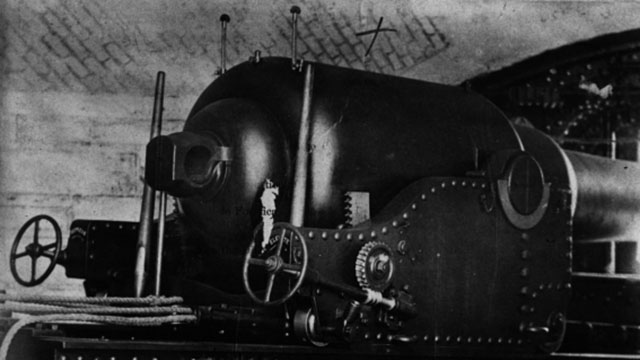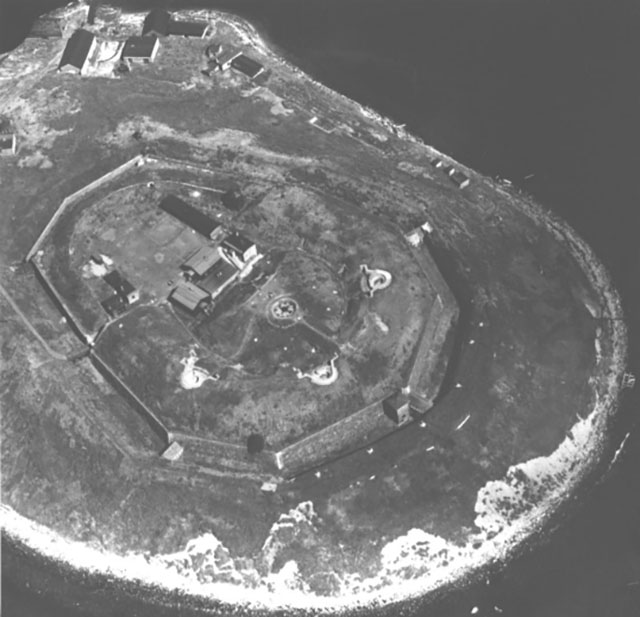
History
Georges Island National Historic Site
History to 1748
The Mi'kmaq
The Mi’kmaq were the first people to live in the Halifax region, which they called Kjipuktuk, or “the Great Harbour,” having arrived after the last ice age, more than 10,000 years before, following the receding glaciers.
The ice had scoured the land and left behind large oval-shaped piles of earth known as “drumlins.” Georges Island is one such drumlin, an island the Mi’kmaq call Elpaqkwitk, “Water splashed on it by the waves.”
Kjipuktuk, part of the larger Indigenous landscape known as Mi’kma’ki (the area generally covering the Maritime provinces), was a key gathering place, harvesting area, and travel way for the Mi’kmaq before Europeans arrived, and long afterwards. It is home to numerous Mi’kmaw cultural sites.
The French
The French, who began arriving in the region in the 17th century in pursuit of fish and furs, called the little island “Île de la Raquette” or “Île Ronde” (Snowshoe or Round Island) because of its tapered oval shape.
The island also featured prominently in a French attempt to recapture the Fortress of Louisbourg. In 1746, France assembled a massive armada of warships under the command of the Duc d’Anville. Unfortunately, the armada was scattered by storms and ravaged by disease. The remains of the fleet limped into Kjipuktuk where d’Anville himself soon died and was buried on Île de la Raquette.
Many Mi’kmaq, who attempted to help the ailing French sailors and soldiers, perished from the same diseases that had killed so many in D’Anville’s fleet. In 1748, Louisbourg was returned to France by treaty, and D’Anville’s remains were moved to the chapel there.
1749-1793
The British
The British came to Kjipuktuk in 1749 to build a naval base to counter the continuing threat that Louisbourg posed to New England. They called the new town Halifax and this little island “George’s Island,” in honour of King George II, and almost immediately built fortifications there due to its strategic location for harbour defence.
From this time onward, the island would be home to many members of the Royal Artillery and other British regiments, and in later years, members of the Canadian Forces.
The Acadians
The Island also served as the town’s first prison as well as an internment camp for Acadians during the eight years of the Deportation. Between 1755 and 1764, the British captured and then detained an estimated 900 Acadian men, women, and children on Georges Island, before they were forcibly deported to other destinations around the world.
At its peak, there were about 300 people confined on the island at one time. Acadians were kept in at least two large sheds on the western side of the island in harsh conditions, especially during the winter. People died here. For the Acadian community, this is a sacred and culturally significant site.
The Seven Years War
While the Seven Years War ended in 1763, the next major conflict followed soon afterwards.
The American Revolutionary War
After the American Revolutionary War began in 1775, the fort on Georges Island was expanded. By the end of that conflict, Halifax was the last naval port on the eastern seaboard remaining loyal to Britain.

1793-1850
Fort Charlotte
When Britain and France went to war again in 1793, after the start of the French Revolution, Halifax’s role as a strategic naval base came to the fore once more. Prince Edward, Duke of Kent and a son of George III (later the father of Queen Victoria), arrived in 1794 to take command of military forces in the region.
Edward set about improving the harbour defences, including building a stronger fort on Georges Island, which he named Fort Charlotte for his mother, Queen Charlotte. Construction began in 1798, resulting in a compact oval gun battery ringed by a defensive ditch. The oldest remaining structures on Georges Island date from this period.
The War of 1812
During the War of 1812 with the United States, a stout Martello Tower was added to Edward’s fort, one of five towers in Halifax. By this time, British military authorities had recognized Georges Island as the key to the defence of Halifax Harbour.

1850-1906
Harbour defence strategy changes
Aside from the addition of several “bomb proof” rifle galleries called caponiers, Fort Charlotte remained unchanged for several decades until advances in military technology required another significant rebuild.
The introduction of ironclad warships in the 1850s led to the development of more powerful rifled artillery, which fired shells farther and with greater accuracy. These new rifled muzzle-loading (RML) guns necessitated a wholesale change in harbour defence strategy. The coastal defences in Halifax, including Georges Island, were re-armed and reconstructed to make use of this latest technology.
Work on the new Fort Charlotte began in 1864 and continued until 1873. The old Martello Tower was torn down and the south end of the fort became a two-tiered artillery battery, with a maze-like underground system of ammunition storage and distribution. Eight 9-inch calibre RMLs were installed in an upper battery and four 10-inch RMLs in the underground lower battery.
In the 1880s and 1890s, the rapid pace of weapons development continued, this time rendering Fort Charlotte’s RML guns obsolete.
Submarine mine system
In response, the British installed a state-of-the-art submarine mine (or sea mine) system, which could rapidly deploy submerged mines across the harbour channel on either side of the island in the event of an attack by an enemy fleet. New artillery in the form of modern breech-loading Quick-Fire guns was also mounted in the upper battery as a defence against fast torpedo boats.

1906-1965
Government of Canada
The Government of Canada assumed responsibility for the Halifax defences from the British in 1906. By then, the increasing ranges of artillery had made Georges Island less important than the newer coastal forts that had been built farther out toward the mouth of the harbour.
First World War
Nevertheless, some of the first Canadian troops mustered for service during the First World War were deployed to Georges Island, where an anti-submarine net was erected on both sides of the island to prevent German U-boats from entering the inner harbour.
Second World War
During the Second World War an anti-aircraft unit was stationed on the island, the last soldiers to serve there.
National historic site
The island was declared a national historic site in 1965.
Related links
- Date modified :